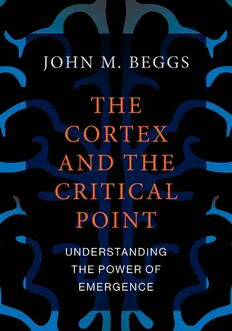
The Cortex and the Critical Point: Understanding the Power of Emergence PDF
Preview The Cortex and the Critical Point: Understanding the Power of Emergence
The Cortex and the Critical Point The Cortex and the Critical Point Understanding the Power of Emergence John M. Beggs The MIT Press Cambridge, Mass ac hus etts London, E ngland © 2022 Mas sa chu setts Institute of Technology This work is subject to a Creative Commons CC-BY-NC-ND license. Subject to such license, all rights are reserved. The MIT Press would like to thank the anonymous peer reviewers who provided comments on drafts of this book. The generous work of academic experts is essential for establishing the authority and quality of our publications. We acknowledge with gratitude the contributions of t hese other wise uncredited readers. This book was set in Times New Roman by Westchester Publishing Services. Library of Congress Cataloging-in-Publication Data Names: Beggs, John M., author. Title: The cortex and the critical point : understanding the power of emergence / John M. Beggs. Description: Cambridge, Massachusetts : The MIT Press, [2022] | Includes bibliographical references and index. Identifiers: LCCN 2021046107 | ISBN 9780262544030 (paperback) Subjects: LCSH: Cerebral cortex. | Brain. | Neurology. Classification: LCC QP383 .B44 2022 | DDC 612.8/25—dc23/eng/20211109 LC record available at https://lccn.loc.gov/2021046107 This book is dedicated to my father, who gave me curiosity and an interest in science. Contents Acknowle dgments ix Introduction 1 I Background 1 The Main Idea 9 2 Emergent Phenomena 27 II The Critical Point and Its Consequences 3 The Critical Point 51 4 Optimality 73 5 Universality 93 III Future Directions 6 Homeostasis and Health 109 7 Quasicriticality 131 8 Cortex 145 9 Epilogue 163 Appendix 169 Notes 183 References 185 Index 201 Acknowl edgments I would not have been able to finish this book without help from many others. It is fitting for me to acknowledge their contributions here. First, I am grateful to Dietmar Plenz, who was my postdoctoral advisor when we dis- covered neuronal avalanches. He gave me the opportunity to work on a proj ect analyzing activity from multielectrode arrays. Neither of us knew what that would bring, and the three years I spent in his lab were filled with amazement at what those data produced. Dietmar is an excellent scientist, and I learned from him how to be more precise and rigo- rous. He is a dynamic investigator and unafraid to tackle the most challenging prob lems. Thank you for teaching me so much. Second, to my colleagues who reviewed early drafts of t hese chapters. To Gerardo Ortiz, a condensed m atter theorist who has educated me tremendously in critical pheno- mena. Thank you, my long- time friend for keeping me honest about the physics. To Ehren Newman, a systems neuroscientist who helped me to make the material more relevant and understandable. Thank you for not being afraid to tell me the truth. “Wounds from a friend can be trusted, but an enemy multiplies kisses” (Proverbs 27:6). To Katy Hagen, a gradu ate student and writer who made the text more readable. Thank you for reading e very sentence and e very comma with a helpful and critical eye. You all have made the book immeasurably better, but the errors that remain are mine alone. Third, to my students, who have r eally done all the hard work on our criticality proj- ects: Rashid Williams- Garcia, Mark Moore, Shinya Ito, Nick Timme, Najja Marshall, and Leandro Fosque; and to Masanori Shimono who was a superb postdoc. Fourth, to Karin Dahmen and Tom Butler, for suggesting we look at the exponent rela- tion and avalanche shape collapse. You have been excellent collaborators and fun to work with. Fifth, to my wonderful collaborators David Hsu and Alan Litke. David introduced me to the possible connections between supercriticality and epilepsy. Alan developed a cutting-edge electrode array that made high-resolution recordings of neuronal avalanches possible. Sixth, to Bob Prior and Olaf Sporns, for believing in me and encouraging me to write this book. It has been as gratifying to do this as you said it would be.
